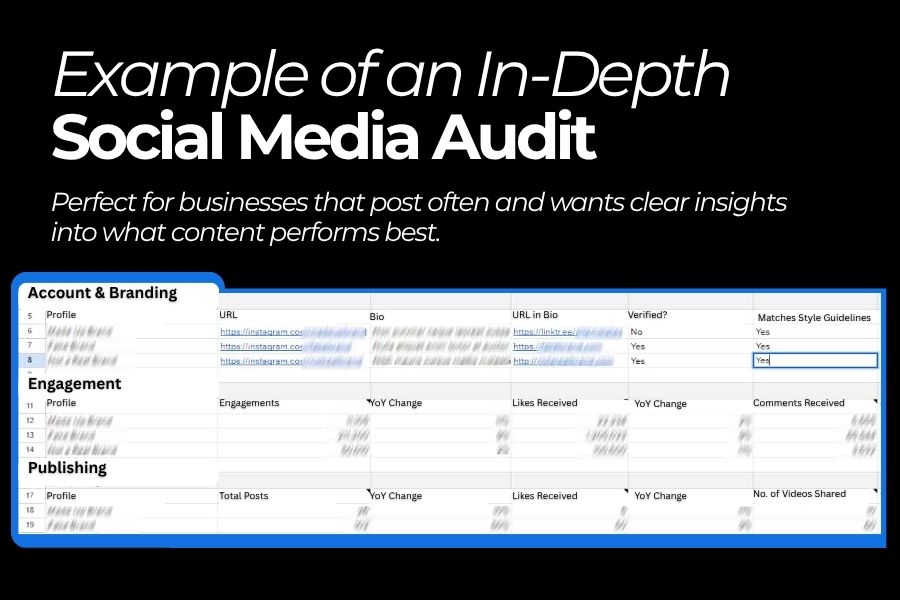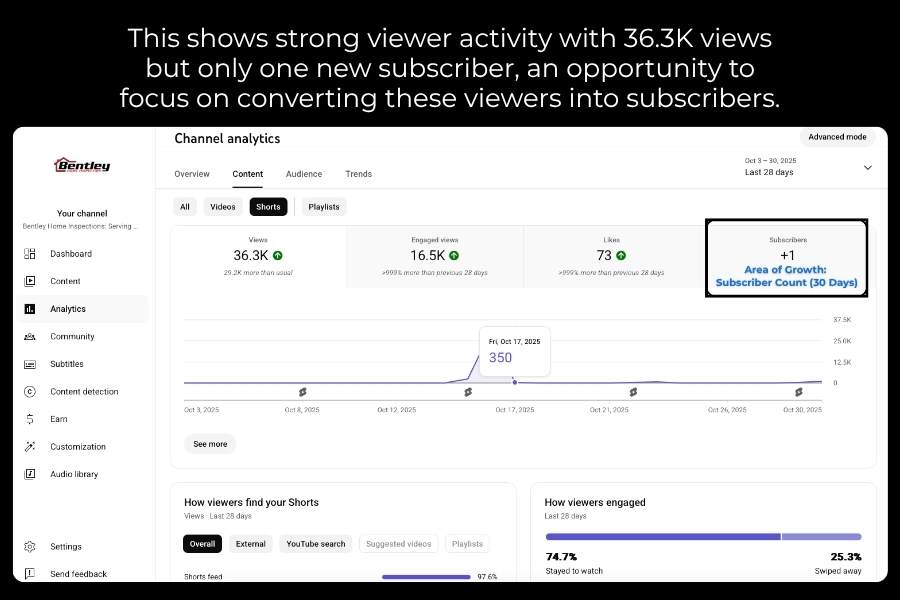Running a social media audit helps you understand what’s working and what’s not across your platforms and with the help of AI, it’s now easier and smarter than ever.
If you manage your own business accounts, you have probably wondered:
Are my posts reaching the right people? Is my content helping me grow?
A social media audit gives you the answers. It allows you to measure what drives engagement, identify what needs improvement, and align your strategy with your goals.
At WolfPack Advising, we have seen how a simple, structured audit can help small businesses go from random posting to strategic success. In this guide, you will learn a step-by-step process you can follow, plus how to use our free social media audit template to track everything with ease.
To make it even easier, here’s a ChatGPT prompt you can use to generate your own Social Media Audit Template for your business. This prompt will help you build a report you can reuse monthly or quarterly to track growth and spot new opportunities.
ChatGPT Prompt:
“I’m a business owner and I want to evaluate my social media performance and find areas to improve.”
“Please act as an experienced social media strategist and create a simple, customizable Social Media Audit Template that I can fill out for my business.”
“The goal is to help me track what’s working, what’s not, and how to grow my online presence more strategically.”

Contents
Step 1: Gather All Your Social Media Accounts in One Place
Start by identifying every platform your business uses, even the ones you have not updated in a while.
Many brands forget about older or duplicate accounts. Those accounts can confuse your audience and weaken your online reputation.
What to do:
- Make a list of all platforms you use.
- Include business pages, side accounts, and old promotional pages.
- Write down URLs, usernames, and who has admin access.
- Note follower counts and when each account was last updated.
Pro Tip: Create a simple spreadsheet for your inventory. Columns might include:
Platform | Handle | Followers | Purpose | Admin Access | Notes
This step gives you a full picture of your online presence and ensures every profile is accounted for.

Step 2: Track the Metrics That Matter
The right data reveals what is driving performance and what needs to change.
Avoid vanity metrics like follower counts alone. Focus on insights that show engagement and conversions.
Metrics to include in your audit:
- Engagement rate (likes, comments, shares divided by followers)
- Reach or impressions
- Click-through rates
- Conversion rate (website visits or inquiries from social)
- Top content types (videos, reels, carousels, etc.)
- Post frequency and consistency
Example snapshot:
| Platform | Engagement Rate | Avg. Reach | Top Post Type | Conversions |
|---|---|---|---|---|
| 4.2% | 1,450 | Reels | Link in bio | |
| 2.8% | 1,900 | Videos | Boosted posts | |
| 3.7% | 980 | Articles | Direct URL |
Once you document this data, you will quickly spot patterns, for example, which platforms deliver the most engagement and which ones underperform.
In our experience, small businesses that complete a full audit and refocus their efforts on high-performing content often see engagement increase within 30 to 60 days.
Step 3: Review Brand Consistency Across Every Platform
A consistent brand appearance helps people trust and recognize your business immediately.
When your profiles look and sound different from one another, it can confuse potential customers and weaken your credibility.
Checklist for consistency:
- Profile pictures and banners match across all platforms
- Bio descriptions use a consistent tone and updated information
- Usernames are similar or identical
- Links direct to the correct website or landing page
- Contact details are up to date
- Brand colors, fonts, and tone are unified
Quick example:
If your Facebook bio says “Open 7 Days a Week,” but your Instagram bio says “Closed Sundays,” you are sending mixed messages. Align those details to build trust and clarity.
Visual suggestion: Create a side-by-side view of your profiles to easily spot inconsistencies.
Step 4: Evaluate Your Content Performance
Knowing what type of content connects with your audience is key to improving engagement.
Every platform has insights tools that show how each post performs. Review your most recent posts and note which ones received the most likes, comments, or shares.
Look for patterns such as:
- Certain topics or visuals that consistently perform well
- Optimal posting times or days
- Post formats that attract more engagement (videos, images, stories)
- Posts that drive traffic or conversions
If you notice that short videos consistently outperform static posts, focus on creating more video content.
Use your audit sheet to list your top five performing posts per platform. Then, identify what they have in common.
Example:
A local fitness studio may find that quick 15-second workout clips generate 60% more saves and shares than standard promotional posts. That insight becomes a clear roadmap for future content.
Step 5: Understand Your Audience
To reach the right people, you need to know who your audience is and what they care about.
Social platforms provide valuable demographic data, such as age, gender, location, and activity times. Use this information to tailor your content strategy.
Keep in mind that the best time to post can vary greatly depending on your industry and audience behavior. For example, B2B audiences might be more active during weekday mornings, while lifestyle or retail brands may see higher engagement on evenings or weekends.
What to analyze:
- Demographic breakdown of your followers
- Locations with the highest engagement
- Devices used most often (mobile vs desktop)
- Times of day your audience is most active
Example snapshot:
| Platform | Top Location | Age Range | Best Time to Post |
|---|---|---|---|
| Orlando, FL | 25–34 | 8 PM | |
| Tampa, FL | 35–44 | 7 PM | |
| TikTok | Miami, FL | 18–24 | 9 PM |
This insight helps you adjust not just what you post, but when you post it.
Pro Tip: Schedule your highest-value content for the times when your audience is most active.
Step 6: Identify Opportunities for Growth
Your audit is only useful if you turn the findings into action.
Once you have analyzed your data, identify what to keep doing, what to change, and what to stop altogether.
Action categories:
- Quick wins: Update outdated bios, unify visuals, fix broken links.
- Optimizations: Post more of what works best, reduce what doesn’t.
- Growth goals: Set measurable targets like improving engagement by 20% or increasing conversions by 10%.
You might also identify entirely new opportunities, such as trying a new platform where your audience is active, or running small paid boosts on high-performing content.

Step 7: Summarize and Systemize Your Audit Process
There is no single right way to run a social media audit. It depends on your goals, time, and number of accounts.
Example 1: The In-Depth Audit
Tracks engagement, audience growth, and posting frequency across all platforms. This approach works best for brands posting regularly and wanting detailed insights into what drives performance.
Example 2: The Quick Audit
A fast checkup using simple “yes” or “no” questions to spot inconsistencies, such as:
- Are visuals and messaging consistent?
- Is the bio link updated?
- Have we posted recently on each platform?
- Which platform is most engaged or growing fastest?
| Step | Quick Audit (Fast Check) | In-Depth Audit (Full Review) |
|---|---|---|
| 1 | Review active profiles | Gather all accounts (active + old) |
| 2 | Check engagement rate | Track detailed metrics |
| 3 | Verify visuals | Review full brand consistency |
| 4 | Spot top posts | Analyze top 5 posts per platform |
| 5 | Confirm audience basics | Deep dive into demographics & timing |
| 6 | Note quick fixes | Identify detailed growth opportunities |
| 7 | Plan next month | Build long-term audit workflow |
Choose the approach that fits your needs, whether it is deep analysis for data-driven insights or quick reviews for ongoing consistency.
Related Questions
Here are some common questions people ask when running their first audit:
1. How often should I run a social media audit?
For most small businesses, once every three to six months works well. Larger brands may benefit from monthly mini-audits.
2. Do I need special tools for an audit?
You can complete an effective audit using free tools available on each platform, plus a tracking spreadsheet or template.
3. How long does an audit take?
A focused audit typically takes one to two hours, depending on how many platforms you manage.
4. What’s the difference between a social media audit and a content audit?
A social media audit focuses on accounts, engagement, and performance. A content audit focuses on the quality and structure of the material you publish.
5. What should I do after completing my audit?
Create an action plan using your insights. Set goals, adjust your posting strategy, and schedule your next review.
Conclusion
A social media audit is more than just an exercise. It is a strategy that helps you understand your audience, measure what works, and make smarter marketing decisions.
When you take the time to gather your data, review your brand presence, and set actionable goals, you put your business on a clear path to growth.
WolfPack’s Simple Social Media Audit Template makes it easy to complete this process in less time and with more confidence.
Take the next step in your social media growth. Our team will review your current performance and create a plan tailored to your business goals. Book your consultation today.






